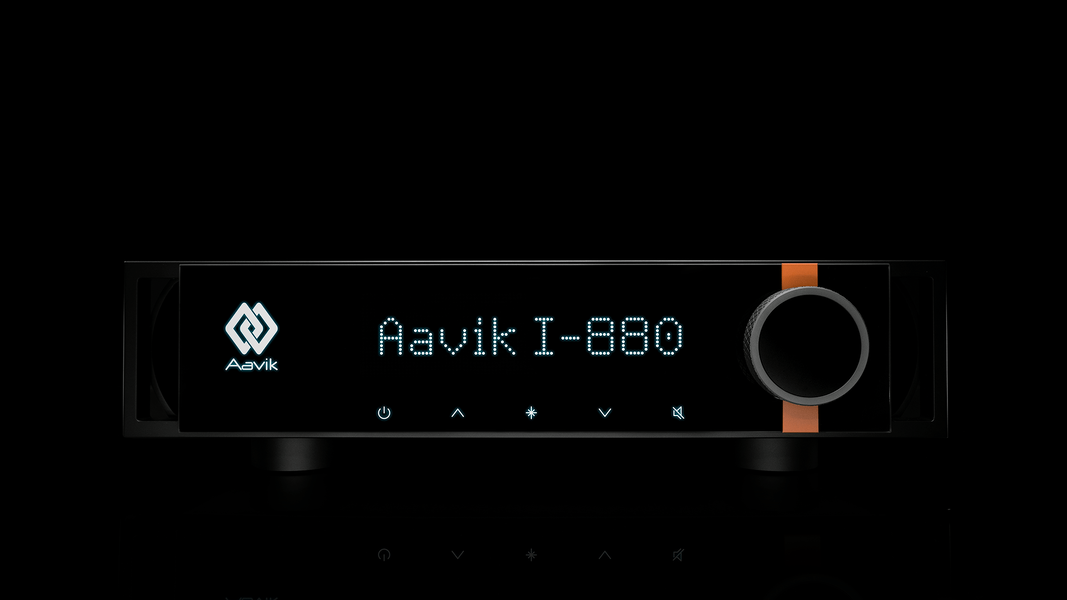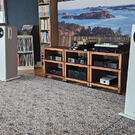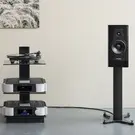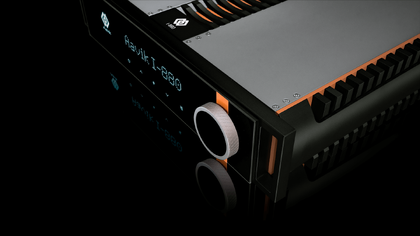
Photo: Roy Ervin Solstad and Audio Group Denmark
Around 187 years ago, the Danish author Hans Christian Andersen wrote a fairy tale about an extravagant emperor who was tricked into believing that he was wearing clothes made from the finest materials. In reality, he was not wearing anything at all and was walking around the town stark naked.
When you bring home an integrated amplifier worth NOK 820,000, you cannot help but wonder whether you are being tricked in the same way as Andersen’s emperor. Surely an amplifier cannot cost that much and you must have been fooled completely if you spend that much money on an amplifier.
This will be on many people’s minds, even if they have never listened to the amplifier or read about the special aspects of the amplifier and its technical solutions. The majority of people will never have the opportunity to familiarise themselves with such a product at all. At least not in the familiar surroundings of home. Listening to a product in an unfamiliar space with unknown components and speakers is, as we all know, a risky business. What do you actually hear most of? The space? The speakers? The amplifier? Or the original source? The truth is that you hear a little bit of everything. That is also the case at home, but changing a component in an otherwise familiar sound source and familiar space then has the potential to more easily reveal differences from what you normally use to play.
Whether or not this justifies the price of the equipment is an individual consideration. For some, even a minor improvement can be perceived as a good investment even if the expense is significant. Others, however, prefer for the improvement to at least correspond to the difference in price between the products.
The challenge – and I’m not only talking about a hi-fi here – when it comes to performance versus price is that there is no fixed mathematical formula. It also doesn’t get any easier when we know that manufacturers often select a price based on what they believe the market will accept rather than a price based on e.g. development and production costs. The fact that we experience, globally in the hi-fi world, that it is easier to sell more products at NOK one million than at NOK 100,000 also does not make it any less tempting for manufacturers to set high prices. Many potential high-end customers – often in Asia and the Middle East – want the absolute best and, as they also imagine that the best must cost A LOT, the prices are often set high in order to satisfy these customers.
But this is far from the only reason. The risk of incurring major losses is also greater if you put more into the pot to manufacture equipment using more expensive components. Unfortunately, it is also a fact that when you have reached such an extremely high level, it will often cost an unbelievable amount to make even minor improvements.
Just ask someone who develops Formula 1 cars what it costs to reduce the lap time at the Silverstone course in England by half a second for a car that has already been tweaked to the max to excel in performance.
Some will always be willing to pay the price, even if the percentage improvement is minimal. This is the case in Formula 1 and in hi-fi too. The biggest improvements are usually found when you move from budget to intermediate, not when you have already reached high-end and want something even better.
The fact that you are unable or unwilling to spend large amounts does not mean that everyone who wants to and can is an idiot, despite the fact that it can seem that way when venturing into various forums or on social media. I know several people who believe that it is stupid to spend more than a couple of thousand kroner on decent earbuds as you can access all the music in the world via Spotify on your phone. Each to their own.
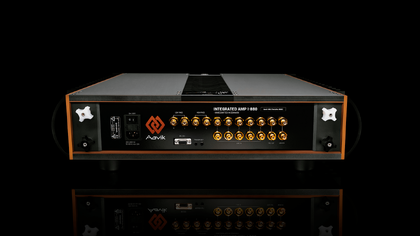
Aavik I-880
On the other hand, however, expensive products should not be shielded from a critical view just because they are expensive. This would be really stupid, as expensive products must be able to withstand greater scrutiny, particularly since they purport to be extremely good at such a price point.
Audio Group Denmark has therefore set itself up for scrutiny with the I-880. Admittedly, there are far more expensive amplifiers around than the integrated Danish amplifier. Audio Note Gaku On at nearly NOK 3 million comes to mind and the Dan D’Agostino creation, Momentum, is also more expensive than the Aavik amplifier.
I have not listened to either of these using my own set-up, so it is unfortunately not possible to carry out a comparative test.
However, what you get with the Aavik I-880 is 200 watts per channel at 8 ohms. That doubles at 4 ohms. The interesting thing here is that the amplifier operates only in class A. This usually means that all power reserves are available at all times. This usually leads to the amplifier becoming very warm and it will usually have less output power than the more common class AB amplifiers that draw extra power when required by the music. However, the four class A amplifier circuits in Aavik I-880 are designed to maintain a constant level of 0.63 volts above what is needed. You therefore end up with a class A amplifier that, strictly speaking, is also more environmentally friendly, as it does not consume more power than necessary. This also means that Aavik was able to design smaller capacitors and position these so that each output transistor ends up with a dedicated capacitor bank next to it. This means that the electricity travels a shorter distance than in ordinary amplifiers. According to the Danes, the shorter signal paths also result in less noise.
Lowering the noise floor has been central to the development of I-880 in order to provide better dynamics and an even more detailed reproduction of the music within a larger soundscape.
The amplifier has, among other things, its own noise regulators with extremely low noise levels. According to Aavik, this noise is measured in microvolts and nanovolts, which means that the noise is far below the level of normal noise regulators. With four power supplies of 500 watts each, I-880 boasts performance of up to 80 ampere peak. This should be more than enough for almost all set-ups.
Aavik has also implemented a special volume control solution, an optic input circuit or infeed isolated in what is virtually a copper box and a sandwich-structured base plate that you can read more about on the manufacturer’s website. It also comes with a passive split filter that allows you to control which signals to transmit to an active subwoofer. This high and low pass filter can also be used as an analogue room correction by connecting a power amplifier for the bass elements of your speaker to the low pass output and a power amplifier for mid-range and treble to the high pass output. The frequency can be configured in the menu.
Connoisseurs of Aavik and Axxess electronics, Børresen speakers and Ansuz cables and power cleaning will undoubtedly be familiar with the concept of Tesla coils, which Audio Group Denmark often uses in products from the four brands. There are plenty of these in I-880. Simply put, Tesla coils are double coils that are coiled in opposite directions. Both coils are live and the idea is that, in the event of a voltage peak, the opposite coil will create an opposite voltage dip. The idea is that this will eliminate the noise from such voltage spikes. Aavik admits that it is not possible to completely remove noise using such Tesla coils, but that parallel connecting such coils allows for improved noise elimination, depending on the number of coils that are parallel connected. Aavik has also developed various types of Tesla coils that will complement one another’s strengths and weaknesses. There are 132 active Tesla coils and 311 active square Tesla coils in the I-880. I could write page after page on the use of these Tesla coils, but anyone who is particularly interested can find further information on the Aavik website.
On the website, you will also find that the I-880 only has imbalanced RCA inputs and outputs. All five inputs can be gain-adjusted from 1-15 decibels (for the first four, with a maximum input level of 4.5V) and from 1-11 decibels for the line 5 input (with a maximum input level of 6.5V). Any of these can be programmed for use with home theatre-bypass. You will receive a preamplifier output and preamplifier input (if you want to use the I-880 as a pure power step).
You will also find a couple of speaker terminals on the rear.
It should be noted that the I-880 is big. It is not particularly tall, but with a width of 58 cm, the amplifier does not fit ordinary racks. The depth of 51.5 cm can also pose a challenge. The display, which spans the entire front and comprises a touch screen to control menu choices, volume and input sources, is also large. It is possible to dim the text, but when turned on, you can more or less see it from the house across the road. Finally, there’s a manufacturer who understands that hi-fi nerds are often a bunch of old men with increasingly poor eyesight. If you can’t read what it says on the I-880 display, you probably need to see an optometrist. Remember your white stick.
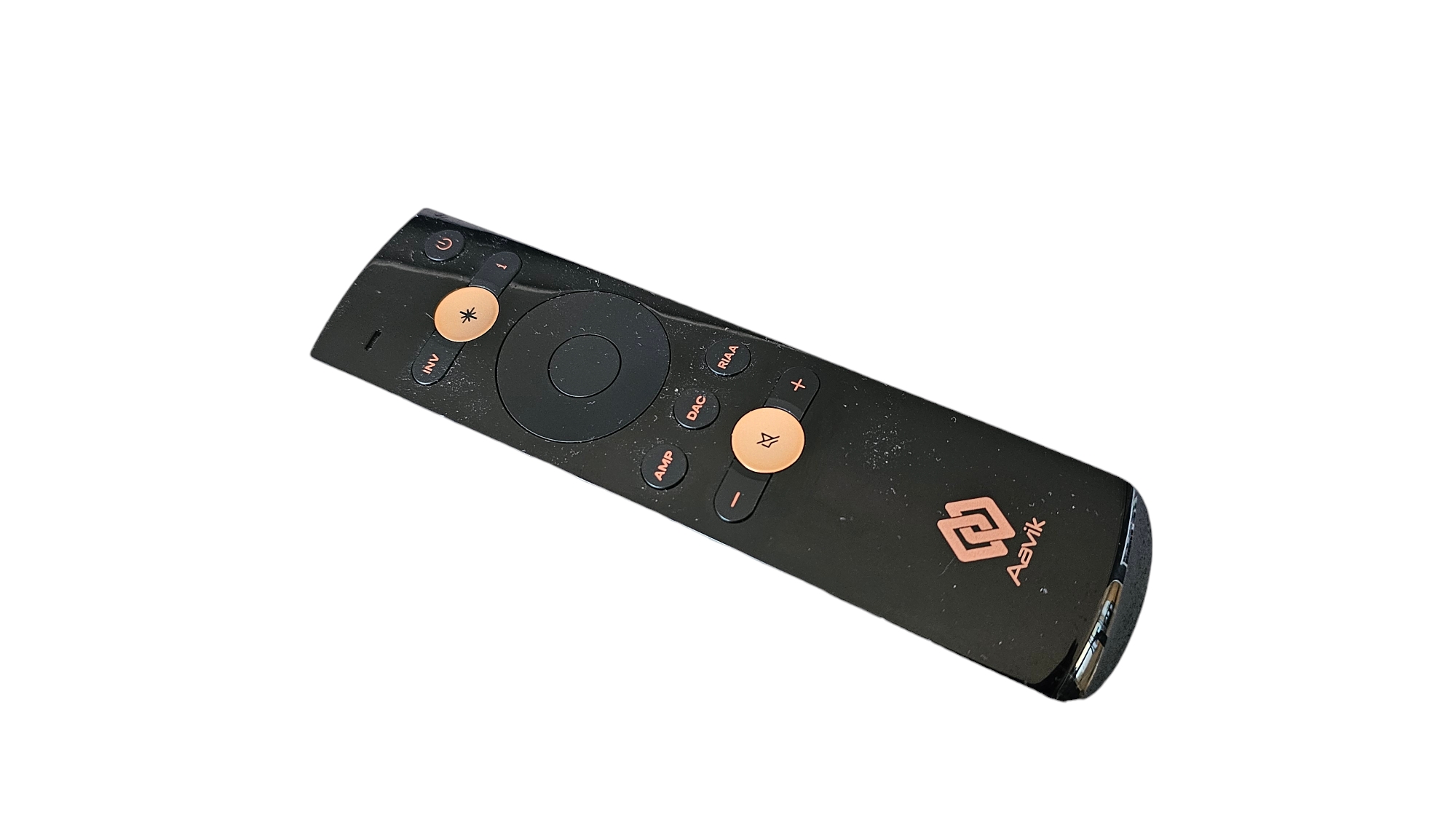
I think Aavik managed to get the design spot on. I find it to be both rugged and beautiful and the large volume dial is impressive. The remote control, however, does not impress. In terms of the design, the colours match the amplifier, but equipping a high-end amplifier worth more than NOK 800,000 with a plastic remote control is, in my opinion, an insult to the customer. I cannot for the life of me understand why manufacturers choose to save on the part of the product that users interact with the most. The remote control for the Aavik I-880 should, of course, be made from black aluminium with copper and grey details, just like the amplifier. The way it is now feels like installing a hard plastic steering wheel in a Rolls Royce. It wouldn’t help if the hard plastic was made to look like the wood used for the dashboard of the Rolls Royce, as the user experience would still be negatively affected. But that is what Aavik did. You can do better!
The packaging, however, is just right for this price level. The amplifier is supplied in a real flight case, which alone weighs more than many amplifiers. That’s how it should be done.

The sound
There is also no reason to complain about the performance of the amplifier itself. After all, it is supposed to compete with the best separate amplifier solutions on the market when it comes to sound, so you are allowed to have some lofty expectations. It’s also pretty cool to listen to a product that the manufacturer believes to be the very best it can create – especially knowing that the technology that was developed will eventually trickle down to more reasonably priced amplifiers over time.
Initially, I was excited about how the amplifier would play compared to my own integrated amplifier, which I felt I had spent an insane amount of money on. However, it costs half a million kroner less than the Aavik amplifier. The question is whether the amplifier will be just as revealing as the Emperor’s New Clothes.
It would have been fun to be able to give a scathing review of the sound quality of the Aavik amplifier, but after giving the I-880 about half an hour to warm up, I had to admit that was not a possibility.
It turns out that the Danish beast is irritatingly good. Don’t get me wrong. It isn’t three times as good as my own amplifier. It’s not even close to being twice as good, so if you’re looking for bang for your buck, there are definitely better options available. However, there are some aspects in which it performs so much better with my set-up and sound preferences that I will feel sad to send it back.
One thing is the noise floor Aavik has been working on. It’s clear they’ve done something extreme, as I have never before experienced the kind of background against which the music is presented. I can even hear the very smallest details slightly more clearly with the Aavik amplifier than I have ever done before. This makes the microdynamics even more credible. However, it’s still not an amplifier that makes you get caught up in the details. What strikes you is the complete calm and control possessed by the I-880. It’s a bit like watching football matches a couple of decades ago when the Italian Pierluigi Collina was the referee. No matter how important the match, no matter how angry the players or how heated the situations, Collina maintained such control that you could just sit down in front of the TV and relax. Collina managed this without any fuss and that’s also the case for the I-880. No matter what you throw at it, whether it’s Rammstein, Rage Against the Machine, AC/DC, Brückner, Wagner, Infected Mushroom or Polish free jazz, the amplifier keeps the music in an iron grip. Perhaps iron grip is the wrong term, as this could imply that the music is not allowed to roam free. It absolutely is. The amplifier provides both full control and complete release at the same time. The I-880 brings the music to life while while reigning in the sound.
The sound balance might be the teeniest bit on the warm side of neutral, but I doubt this would be an issue for anyone. There are more than enough details and the treble simply seems to be there without going over the top. When something happens high up in frequency, you will notice. The treble is both airy and full of energy. That’s actually the case throughout the entire frequency range. The mid-range is incredibly transparent and it seems as though both instruments and voices have more space around them. It’s as though the instruments and voices do not interfere with one another. They are crystal-clear and separate within the soundscape without the overall experience feeling divided. You get it all, but it’s easier to concentrate on following a single voice or instrument.
Of course, this could also be because the reproduction of the recording studio is so good. Here, both the breadth and the depth are in place, with a precision that is at a level often associated only with high-quality tube amplifiers.
It’s tight in the mid-bass and bass, but not too tight. Here too, the resolution and absence of distortion and microscopic background noise help make it easy to distinguish between different sounds a long way down into the bass register. The force is excellent and the dynamics that can be found in the major deflections of the music are reproduced at full strength. Several times now I have tried to find something missing in the sound, but I can’t find anything. I have listened to amplifiers with even more bottom pull in the mid-range, but the I-880 plays with such authority even there that it’s more a case of personal preference than one being better than the other.
Nevertheless, it’s not easy to say that the I-880 is an amplifier that will satisfy everyone. When you reach such a high sound level, it’s probably just as much about choosing the manufacturer that has stretched your sound preference as far as possible. Not all expensive amplifiers sound the same, even if they all play excellent bass, mid-range and treble. However, I believe that the I-880 could represent the end-game for those who want the best from both the transistor and tube world without having to make too much of a compromise on either side.
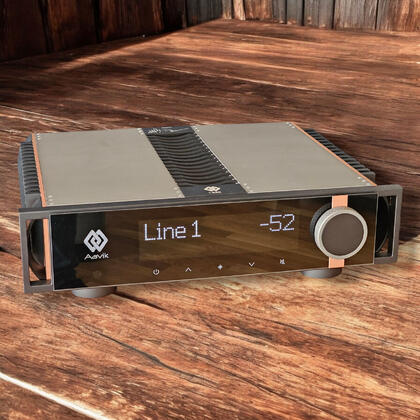
Conclusion
The Aavik I-880 provides excellent sound and has a fantastic build quality, but it is also incredibly expensive. With an extremely low noise floor and even though many will feel that NOK 820,000 has to be a fraud along the lines of the Emperor’s New Clothes, the sound is so transparent that you can “see” everything, just like in Andersen’s fairy tale. The I-880 is unusually transparent and draws an enormous and precise soundscape with a fantastic bass, mid-range and treble. Those of us whose bank balance is more modest can only hope that Aavik will create cheaper amplifiers with nearly as wonderful sound quality as the I-880 in future. It has definitively proven that the Danes know how to create extremely good sound experiences for those who don’t need to look at the price tag. Fortunate are those who can afford it. The I-880 is an extremely good amplifier.

 Vipps oss en gave: 129702
Vipps oss en gave: 129702